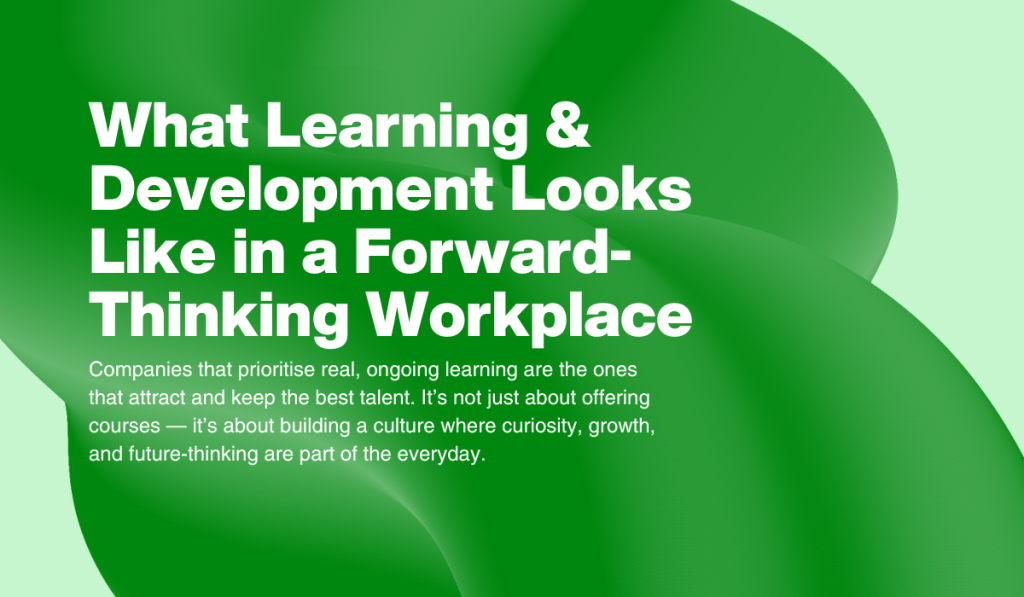“Professional development” might have meant occasionally clicking through a Powerpoint deck and ticking some boxes – but now? That doesn’t count for much. In today’s fast-changing world of work, companies that prioritise real, ongoing learning are the ones that attract and keep the best talent. It’s not just about offering courses — it’s about building a culture where curiosity, growth, and future-thinking are part of the everyday.
So what does a culture of learning and development look like in a workplace that’s truly forward-thinking? Let’s break it down.

1. It’s Continuous, Not Occasional
In traditional workplaces, development often gets boxed into a formal training session once or twice a year. In progressive ones, learning is built into the rhythm of the week.
That could mean:
- On-demand learning platforms employees can tap into when needed
- Regular skill-sharing sessions across teams
- Monthly workshops or short-form learning instead of one-size-fits-all seminars
In a forward-thinking culture, learning is part of how people work — not something they “pause” to do.
2. It’s Personalised
Not everyone’s on the same path, and not everyone learns the same way. Forward-thinking workplaces recognise this and offer different learning tracks, tools, and formats.
Some people thrive with online courses. Others prefer mentorship, peer learning, or hands-on experience. The most effective L&D programs adapt to the individual — not the other way around.
A great learning culture encourages employees to reflect on where they want to grow, perhaps even work it into their learning plan and into their performace review, giving them the tools to take ownership of that development.
3. It’s Tied to Real Roles and Real Goals
Learning for the sake of learning is great — but learning that supports both individual and company growth? That’s where the magic happens.
Progressive companies align learning opportunities with actual career pathways. If someone wants to grow into leadership, they’re given not just theory but chances to lead. If a team is adopting a new tool, they’re trained in a way that’s practical and immediately applicable.
This makes learning feel relevant and helps employees see a clear connection between development and progression.
4. It Encourages Cross-Functional Learning
A forward-thinking approach doesn’t keep learning in silos. Instead, it encourages knowledge-sharing across departments.
Maybe a marketer sits in on a product development meeting to understand user needs better. Or an HR professional learns the basics of data analytics to track engagement more effectively.
This kind of cross-learning makes teams more agile, well-rounded, and better equipped to innovate. It also helps employees build empathy and stronger working relationships across roles.
5. It’s Backed by Leadership
In workplaces where development is taken seriously, learning is modelled from the top. Leaders talk about what they’re learning. They share resources. They ask for feedback and show that growth isn’t just for junior staff.
When development is supported by managers and leaders, not just HR, it becomes a real part of company culture, not a checkbox exercise.
6. It Looks Beyond the Role
Forward-thinking L&D isn’t just about helping people do their current jobs better. It’s about helping them grow into future ones — including roles that might not even exist yet.
This might include upskilling in digital tools or AI (we can never know where AI will lead us and what jobs will come out of it); leadership development for high-potential team members; encouraging creative problem-solving and critical thinking as well as supporting side projects or internal mobility
It’s not just about productivity — it’s about investing in potential.
What It Comes Down To
At its core, learning and development in a forward-thinking workplace is about trust. It’s the belief that people want to grow, and that when given the right support, they’ll rise to meet the future — not just for themselves, but for the company as a whole.
And in a world where change is constant, a culture that prioritises learning isn’t just a perk. It’s a competitive edge.
View all of our latest course listings here.
Share this article with a friend or colleague.



